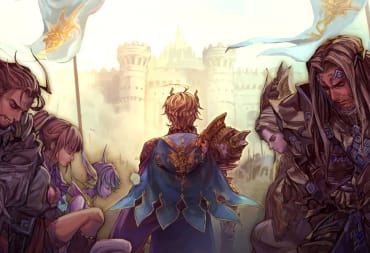Brigandine: The Legend of Runersia is a game with a surprisingly long lineage. The sequel to 1998’s Brigandine: The Legend of Forsena, Legend of Runersia is an updated, modern take of this obscure title from the PS1 days. Incorporating a mix of turn-based and grand strategy elements, Brigandine: Legend of Runersia is a mechanically complex if uneven game for anyone looking for a tactical RPG fix.
In Brigandine, players take control of one of six different nations vying for dominance on the continent of Runersia by deploying powerful warriors and mages known as Rune Knights against each other. Most of the nations are also in the possession of the brigandine, a magical artifact that bestows powers from the gods upon these nations. Of course, this follows a fairly standard high-fantasy plotline, but the narrative takes a major backseat to the real meat of Brigandine, it’s combat.

Marching Forth to Victory
The true strength of Brigandine is its tactical gameplay. Players control two different troop types, Rune Knights, and Monsters. They deploy together in platoons on the battlefield against other nations. Rune Knights serve as the commanders of your units coming in a variety of different classes and leveling up as they gain proficiency. The monsters serve as your troops, eventually transforming into powerful beasts with new abilities. You have limited slots in your platoon for monsters, but those that participate and survive battles gain enough experience to grow in their power and stats.
You can win battles in Brigandine by eliminating enemy Rune Knights, so most of the strategy lies in positioning your troops and overwhelming enemy forces. A lot of base statistics are attached to each character, from agility to defense, which in turn enhance their combat abilities. You also have mana upkeep costs for monsters to consider, adding a light touch of resource management into the mix, though it is fairly negligible. Troops also receive bonuses for the type of terrain you fight on, hitting elemental weaknesses, and using magical buff and equipment to enhance fighting prowess and defenses.
All of these options and statistics offer tons of tactical complexity to consider. In effect, it does lead to some intense moments and fights that can satisfy tactical ingenuity. The games A.I tends to follow a singular strategy of swarming your front lines though, which does damper the experience somewhat. The harder difficulties see Troops using a lot more buffs and magical spells, but the primary strategy is always to rush and overwhelm in each encounter with little consideration to defensive strategies, splitting troops, or other tactical options. Most of the tactical play ultimately comes from the player to make decisions on how to engage enemy forces.
The strategic options actually have depth though outside of the standard win conditions of each battle. Monsters, for example, die in Brigandine and do not respawn. While you can revive them, they require a rare resource and mana points to restore, so taking down monsters to whittle down the numbers and resources of the enemy's army is just as viable a strategy than focusing on enemy Rune Knights. Each battle is on a turn limit, so players need to measure the risks/rewards within the allotted turns to maximize their results.

Trouble on the Homefront
The combat in Brigandine is excellent, but the rest of the strategy elements are sadly bare bones in comparison. There are two phases per season for your campaign, the Attack Phase, where you can select multiple Knights to attack nearby castles, and the Organizational Phase, where you can summon monsters, move units, level up troops, and go on quests. Completing quests nets you valuable equipment and items for upgrading your troops. They can also help you train your existing Rune Knights and recruit new ones if your bench is looking thin. A total of 100 different characters are in Brigandine, though they all have cardboard personalities that borderline anime-styled caricature instead of deep and complex characterization.
There are other options in the Organizational phase as well, though most of them are minor adjustments to your armies and monsters. A lot of it though lacks real depth; quests for example have no meat or objectives to them; you simply pick from a selection of randomly generated locations and receive a random piece of gear. Training also nets small amounts of experience, which is good for leveling up low-leveled monsters, but a poor choice for most of your Rune Knights.
In truth, the organizational phase pales in comparison to the attack phase. Outside of maneuvering or leveling up your troops, there is really not much in terms of strategy to consider other than stuffing your front lines with troops and monsters to stave off invasions. In fact, that is such a dominant strategy that most of the time the enemy A.I doesn’t bother to invade if you have any form of defense on lower difficulties, giving you time to build up your armies and resources without much of a penalty.

A Long-Winded Tale
For those looking for a deep, engrossing narrative, Brigandine is fairly shallow. Much of the story is narrated with schmaltzy, overstuffed purple prose and exposition. It sounds good, almost like a romantic fantasy novel, but really lacks any sort of impact or frame of reference for the player, leading to over-explanation that becomes relentlessly boorish. It is hard for me to ultimately care about these characters when their stats and battle prowess are more important than their motivations.
Though the narration is incredibly flat, at the very least the in-game artwork during these cut-scenes is gorgeous visually. The character art and in-game art scenes are one of the strengths of Brigandine’s presentation, featuring a soft and stylized watercolor feel. Each Rune Knight is given a unique portrait that compensates for their lack of in-game character.
Outside of the main storyline, there's also an unlockable Challenge Mode, which acts as a sandbox where you can create a semi-customizable army by choosing a nation and a list of Rune Knights unlocked in the main story. The Challenge Mode scores the player on their speed and performance while trying to fulfill 10 different victory conditions over the course of a single campaign. It’s a nice distraction from the dull narrative putting more focus on Brigandine's mechanical strengths.

Brigandine: The Legend of Runersia Review | Final Thoughts
Brigandine: The Legend of Runersia is a solid example of a game that can transcend its shortcomings. Most of the mechanics are fairly thin, but the bulk of Brigandine’s combat elements are complex, engrossing, and polished. A one-trick pony for sure, but it’s a well done, well-executed trick that is worth your time. Brigandine ultimately serves up great tactical gameplay that you’ll want to master whether you’re a newcomer or a hardened tactical veteran.
TechRaptor reviewed Brigandine: The Legend of Runersia on the Nintendo Switch with a copy provided by the publisher.
Review Summary
Pros
- Diverse Set of Tactical Options...
- Tons of Troop Types to Experiment With...
- Gorgeous Portrait Art...
Cons
- ...Overall Weak A.I.
- ...Lack of Meaningful Mechanics Outside of Battle.
- ...Paper Thin Characters and Plot.
Have a tip, or want to point out something we missed? Leave a Comment or e-mail us at tips@techraptor.net








